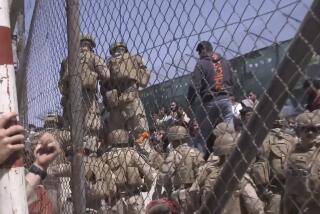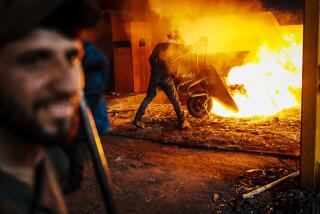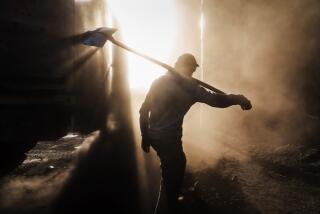Afghan attacks send a message
- Share via
BAGRAM, AFGHANISTAN — With two back-to-back strikes at symbols of American power in Afghanistan, the Taliban movement appears determined to show strength and build prestige in advance of an expected confrontation on its home turf of Kandahar province.
The high-profile attacks in a span of 24 hours -- a rare frontal assault Wednesday on the sprawling U.S.-run Bagram airfield, and a suicide strike a day earlier on one of the ubiquitous American military convoys that traverse Kabul, the capital -- appeared calculated to demonstrate the insurgents’ ability to strike at will beyond their traditional bastions in the country’s south and east.
The Taliban also may be seeking to telegraph resiliency in the face of a concerted U.S.-led campaign to capture and kill mid-level insurgent field commanders.
Additionally, the militants may be hoping to further erode public confidence in President Hamid Karzai as he prepares to convene a large-scale jirga, or tribal consultative meeting, at month’s end. The gathering is expected to discuss whether or how and when to carry out peace talks with the Taliban, a goal President Obama seemed to embrace last week during a meeting of the two presidents.
The insurgents “are always trying to make a point,” said U.S. Army Col. Wayne Shanks, spokesman for NATO’s International Security Assistance Force. Taken together, the strikes in Bagram and Kabul seemed intended to sow “alarm and confusion” at a politically and militarily sensitive juncture, he said.
The attack on Bagram, a sprawling and heavily fortified enclave an hour’s drive from the capital, began just before dawn.
A squad of attackers, some in suicide vests and some clad in uniforms resembling those used by foreign forces, struck the base with rockets, grenades and small-arms fire, military officials and local police reported.
A full-on assault against such a large, well-protected installation had almost no chance of success. But the insurgents probably reaped propaganda points, in the eyes of some, because Bagram carries symbolic weight.
The base is not only the seat of the U.S. military in Afghanistan but houses a prison that is for the insurgents a hated symbol of American detention practices. And though the militants did not succeed in penetrating the perimeter defenses, they did manage to bloody the defenders: Nine troops were wounded and an American contractor was killed.
Although Taliban losses were far heavier -- about a dozen dead, according to the Western military -- the attack showed the insurgency’s willingness to expend fighters on what was essentially a suicidal mission.
Afghan police and military officials described skirmishes that went on for hours as coalition forces hunted down the attackers in farm fields surrounding the base.
The base was on heightened alert for much of the day, with parts of the installation cleared of personnel and military flights in and out employing defensive measures such as use of chaff and flares.
Although the assault at Bagram would have required careful planning, the suicide bombing of the convoy a day earlier was more a matter of a swiftly seized opportunity. It would have been difficult for a bomber to track and target the motorcade of armored SUVs. Such convoys are often used to ferry VIPs around the capital.
The identities of the five U.S. military personnel killed in the massive blast in Kabul had not been released, but it is possible that at least one of the victims was a high-ranking officer. Canadian officials said a colonel also slain in the attack was their highest-ranking officer killed to date in Afghanistan.
Attacks such as the Tuesday strike, which also killed 12 Afghan civilians, tend to fan resentment of foreign forces, even when Taliban fighters are the ones killing noncombatants. Many Afghans feel endangered by the presence of Western troops on crowded urban roadways because the foreign forces are a magnet for insurgent attacks, and bystanders usually take the brunt.
Though the Taliban tied the two attacks to a spring offensive it announced this month, military officials questioned whether there was direct linkage between the strikes at Bagram and in Kabul. Different insurgent cells operate in the areas; a spate of attacks in Kabul has been largely blamed on the Pakistan-based Haqqani network, whereas separate insurgent groups are thought to operate on the Shomali plain, where Bagram lies.
The North Atlantic Treaty Organization appeared eager to dispel the notion that the Taliban would go unchallenged in Afghanistan’s south, the movement’s spiritual home. The Obama administration has committed additional military forces this year -- there were 87,000 troops in the country at the end of last month, with a total of 98,000 expected by late summer -- in part with the goal of pursuing insurgents in that region.
Western officials have described the upcoming campaign as a complex mix of security and political measures aimed at bolstering the authority of the Karzai government in strategically crucial Kandahar province.
Mark Sedwill, NATO’s chief civilian representative, told reporters in Kabul on Wednesday that the campaign was “on track.”
More to Read
Sign up for Essential California
The most important California stories and recommendations in your inbox every morning.
You may occasionally receive promotional content from the Los Angeles Times.













